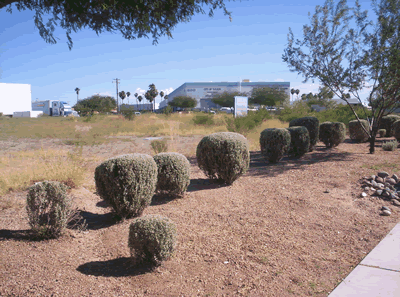Summer Smarts for Landscapes
Protect your valuable landscape investment against the scorching sun
As temperatures begin to rise into the triple digits, people tend to seek refuge in air-conditioned buildings. Plants, firmly rooted in the soil, must tough out the scalding heat and damaging UV rays. While it is common to see landscapes stressed in the summer months, there are some easy steps you can take to keep yours healthy and inviting all year long.
Make sure your plants have an adequate supply of water, but not too much. With our winter rains, many trees and shrubs receive the long, slow irrigation they desire. As our clay soil can hold onto moisture for a very long time, it is wise to wait until the soil feels dry to the touch before turning your irrigation system back on.
While you are waiting for your soil to dry out, it is a good time to do an irrigation system check-up. Check that your timer is in working order, make sure all your drip emitters are firmly in place, look for broken sprinkler heads, check for any leaks, and plug up any drip lines that are watering a plant that no longer exists. Lawn sprinklers should be checked to see that even coverage hasn’t been affected by sand or debris in the sprinkler heads.
To make sure your plants are receiving the correct amount of water, it helps to take an inventory of the plants on your property. For established plants, watering depends on their type. Non-desert varieties like ash, ficus, and privet will need a deep watering once each week during the summer months. Native and desert-adapted varieties such as mesquite, acacia, and oleander can almost survive on their own with occasional deep soaking once a month. If we have a wet monsoon season, watering on all types of established trees and shrubs can be greatly reduced.
It is always best to plant in the fall, but if you are replacing any plants this spring they will need daily watering for the first few weeks, or until the monsoon rains arrive. As a general rule of thumb, once desert adapted plants have made it through the first summer, you can cut back on the water dramatically. For higher water use plants, you will still want to cut back the water once established, but not as severely.
Wait until new growth has emerged before you prune away frost-damaged stems on plants like lantana and bougainvillea. Generally our last frost date is around February 15th, but check your local paper. It is wise to avoid pruning plants during the summer months. Minor pruning on native trees such as palo verdes, ironwoods, mesquites, and acacias can be done in the month of May, but as a general rule, it is best to leave pruning until the fall. Leaves from the canopy of a plant shade inner branches; removing leafy growth will expose stems to the scorching sun. Some plants can suffer from severe sunscald if over-pruned. If your trees must be pruned up for safety or access, and they are sun-sensitive, consider painting their trunks with some watered-down latex paint. Whenever you prune remember to remove only 25% of the plant canopy in one growing season. Constant sheer pruning of shrubs makes them more susceptible to sunscald and makes them less water efficient.

Photographer: Christina Bickelmann
An example of sheer pruning.
When mowing the lawn, be sure to remove only 1/3 of the blade of grass at a time. Setting the mower blade lower to the ground will not only stress the grass. The grass will actually increase its growth rate to compensate, and you will have to mow more often. When applying fertilizers to grass, do so in the morning and time an irrigation to occur soon after application. Fertilizer that is not properly watered into the soil can burn the grass.
Do not spray garden chemicals such as insecticides when temperatures are above 90 degrees. The combination of heat and sun can cause some of these chemicals to be toxic to plants. For insect troubles, consider a strong spray of water on the plant early in the morning. A jet of water will often knock insects like mites and aphids off the plant and they cannot climb back on. If you have no choice but to spray, do so in the early morning before the temperatures creep up.
Mulch is a great addition to any landscape. All plants benefit by having a layer of mulch on top of the soil. A two- to three-inch layer will insulate the soil from the warm air temperatures and will also help retain water in the soil. Mulches can be organic such as bark or compost or inorganic like crushed granite. Make sure you keep your mulch at least two to three inches away from the trunk of the plant.
Following these simple suggestions will keep your plants healthy and your landscape looking great even in the dead of summer.
Kathleen Moore
Water Conservation Coordinator
City of Chandler